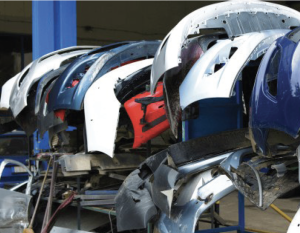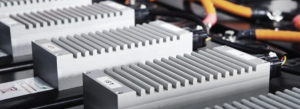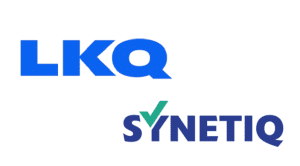BOOSTING BUMPERS
 Ultra-Poly and Autoneum North America, have collaborated to develop a composite material that utilizes recycled bumper material as a rigid backing substrate for a fibrous layer. This composite is used for vibration and noise attenuation in a chassis component, contributing to improved performance and functionality, according to the partners. The development was inspired by Ultra-Poly’s participation in the Plastics Industry Association’s End-of-Life Vehicle (ELV) Recycling Project when the company recognized the potential of recovered fascia in polypropylene (PP) compounds and nonappearance applications within the automotive market. To obtain the recycled bumper covers required for this product, Ultra-Poly directly collects them from bodyshops. These bumper covers have been carefully removed from vehicles and stripped of any usable connected components.
Ultra-Poly and Autoneum North America, have collaborated to develop a composite material that utilizes recycled bumper material as a rigid backing substrate for a fibrous layer. This composite is used for vibration and noise attenuation in a chassis component, contributing to improved performance and functionality, according to the partners. The development was inspired by Ultra-Poly’s participation in the Plastics Industry Association’s End-of-Life Vehicle (ELV) Recycling Project when the company recognized the potential of recovered fascia in polypropylene (PP) compounds and nonappearance applications within the automotive market. To obtain the recycled bumper covers required for this product, Ultra-Poly directly collects them from bodyshops. These bumper covers have been carefully removed from vehicles and stripped of any usable connected components.
BE THERE OARA BE SQUARE
 OARA’s annual convention and trade show is set for March 21-23, 2024. With companies like Copart, Solera/Hollander, IAA and the United Catalyst Corporation set to exhibit, in addition to keynote addresses from JC Cahill and Donald Cooper, this highly anticipated meeting of OARA members will truly be a can’t-miss event.The Thursday afternoon preceding OARA’s two full convention days will feature a roundtable discussion with a select number of invited industry stakeholders. By Friday, educational programming, as well as a trade show will be in full swing. Breakfast, a few more panels and seminars will end Saturday afternoon. OARA’s 2024 Convention and Trade Show is set to run from March 21, 2024, to March 23 at the Hilton Toronto/Markham Suites Conference Centre just north of Toronto.
OARA’s annual convention and trade show is set for March 21-23, 2024. With companies like Copart, Solera/Hollander, IAA and the United Catalyst Corporation set to exhibit, in addition to keynote addresses from JC Cahill and Donald Cooper, this highly anticipated meeting of OARA members will truly be a can’t-miss event.The Thursday afternoon preceding OARA’s two full convention days will feature a roundtable discussion with a select number of invited industry stakeholders. By Friday, educational programming, as well as a trade show will be in full swing. Breakfast, a few more panels and seminars will end Saturday afternoon. OARA’s 2024 Convention and Trade Show is set to run from March 21, 2024, to March 23 at the Hilton Toronto/Markham Suites Conference Centre just north of Toronto.
LOOK AT LKQ
LKQ Corporation recently released its 2022 Global Sustainability Report in which the aftermarket salvage giant says it processed 770,000 vehicles in 2022, recycling 97 million pounds of aluminum, nearly seven million pounds of copper and more than 123 million pounds of scrap steel.The company says the total number of individual parts it sold in 2022 was approximately 13 million. LKQ also recovered more than 1.4 million catalytic converters; recycled more than two million tires and processed nearly one million tons of crush auto scrap materials. Other highlights from the report include LKQ’s progress toward a net-zero greenhouse gas emissions goal for 2050; details on the company’s first inclusion group, the LKQ Veterans Network; the newly adopted Global Supplier Code of Conduct; LKQ Community Foundation activities in 2022 and more.
GENUINE USE
Mitchell shared its 2023 second-quarter insights for Canadian and U.S. EV repair claims where it said electric vehicles use OEM parts in repairs far more than ICE vehicles. According to Mitchell’s data, 90.75 percent of parts used in EV repair claims are OEM; for ICE repair claims, 66.5 percent of parts utilized are OEM. Mitchell data also says just 13.49 percent of parts are repaired on EV claims, compared to 19.20 percent on ICE vehicle claims. Claims severity is also higher with electric vehicles. Mitchell’s Plugged In reports also outline the top North American markets based on its claims data. British Columbia has claimed the number one spot in all reports since Q4 2022, when Mitchell released its first report, and continues to rank number one in Q2 2023, with 5.22 percent EV claims. California is second (4.32 percent EV claims), while Quebec takes third (3.10 percent EV claims).
MAGNETIZING MANUFACTURING
Cyclic Materials has recently launched a pilot plant in Kingston, Ontario, aimed at recycling magnet materials from end-of-life products. The pilot plant project is specifically employing Cyclic’s proprietary technology, Mag-Xtract, which separates rare earth elements in permanent magnets from end-of-life products and parts such as traction electric motors. Initial results show that the pilot plant has processed several tons of the magnet feedstock per day and has the capacity to produce 1,000 kg/hour or 8,000 tons per year of material. Since 2021, Cyclic Materials has been developing a two-step hub-and-spoke model recycling process for rare earth materials. The company aims to economically, sustainably and domestically turn end-of-life products and parts into valuable raw materials that can be reused in the supply chain of electric vehicles and other technological products.
BOOST FOR BATTERIES
Quebec recently launched a “first-of-its-kind” electric vehicle (EV) battery recovery program designed to collect, transport, repurpose, remanufacture and recycle end-of-life EV batteries—specifically, fuel cells that fall outside of the established OEM management programs. The EV Battery Recovery Program is the result of a collaboration between vehicle manufacturers that worked with Call2Recycle to develop and launch the EVBatteryRecovery.ca platform, leveraging the organization’s extensive experience in end-of-life battery management for multiple businesses and sectors across Canada. The program is funded by the participating OEMs—which include Honda, Acura, BMW, Dodge, Fiat, Nissan, Tesla, Volkswagen, Mercedes-Benz and many more—and offered to dismantlers, shredders, independent repair and service facilities, dealerships, fleet operators and even individual vehicle owners. The program also supports the sustainable management of EV batteries and the further development of a circular economy for these valuable resources.
UNITED EFFORT
 A paper from a team of U.S.-based researchers claim that a more robust electric vehicle battery recycling infrastructure will be the key to keeping automakers stocked with the necessary precious metals. Dr. Linda Gaines of the Argonne National Laboratory, alongside her four co-authors, put forth a research paper asserting that the U.S. does not currently have enough nickel or cobalt to support even a single year of solely domestic EV production, but that some hope may lay in the recycling sector. About 54 percent of end-of-life EV batteries wind up in an auto recycling yard, though only about ten percent of those yards are in the U.S., while the rest are in China, according to data cited from 2019. However, the paper points out that end-of-life batteries “will not make a significant contribution to the overall U.S. battery material supply until well into the 2030s because of the long product lifetime and rapid demand growth for the dominant products.”
A paper from a team of U.S.-based researchers claim that a more robust electric vehicle battery recycling infrastructure will be the key to keeping automakers stocked with the necessary precious metals. Dr. Linda Gaines of the Argonne National Laboratory, alongside her four co-authors, put forth a research paper asserting that the U.S. does not currently have enough nickel or cobalt to support even a single year of solely domestic EV production, but that some hope may lay in the recycling sector. About 54 percent of end-of-life EV batteries wind up in an auto recycling yard, though only about ten percent of those yards are in the U.S., while the rest are in China, according to data cited from 2019. However, the paper points out that end-of-life batteries “will not make a significant contribution to the overall U.S. battery material supply until well into the 2030s because of the long product lifetime and rapid demand growth for the dominant products.”


























